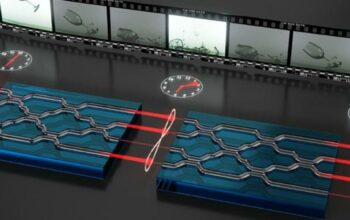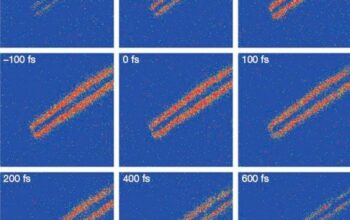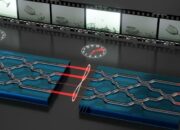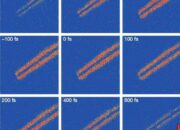In the ever-evolving realm of nanotechnology, the pursuit of constructing nanomagnets at the atomic scale presents an enthralling venture into the deeper principles of magnetism. Just as a maestro orchestrates a symphony, each atom in this endeavor contributes its unique note to the harmonious ensemble of magnetic functionality. The manipulation of magnetic properties at the atomic level not only reveals the intricacies of fundamental physics but offers pathways for revolutionary applications across various fields, from data storage to quantum computing.
The foundation of magnetism is predicated upon the alignment of magnetic moments, which are inherent to atomic structures. At the nanoscale, these moments become pivotal, akin to building blocks in a game of Tetris, where the orientation and position of each piece dictate the game’s outcome. Researchers strive to fabricate nanomagnets one atom at a time, akin to artists meticulously arranging tiny pigments to compose an intricate mural. This precision enables the tuning of magnetic properties with remarkable finesse, thereby yielding bespoke materials engineered for specific functionalities.
Central to this endeavor is the principle of magnetism itself, primarily derived from the electron spin and orbital angular momentum. Electrons exhibit duality, functioning not only as particles but as waves, encapsulating a rich tapestry of quantum behaviors. At the nanoscale, these quantum effects amplify, leading to phenomena such as superparamagnetism where the material’s magnetic properties fluctuate with temperature changes. Understanding these phenomena is crucial for successful manipulation, as it dictates the operational thresholds of the crafted nanomagnets.
One of the most intriguing methodologies for constructing nanomagnets is via bottom-up approaches, including chemical vapor deposition and atomic layer deposition. These techniques serve as conduits for assembling materials atom by atom, allowing for unparalleled control over the composition and morphology. Picture a potter shaping clay into a delicate form; here, scientists meticulously deposit atoms to fabricate nanoparticles with defined facets and orientations, enhancing the magnetic anisotropy—the directional dependence of a material’s magnetic properties. The intricate dance between each deposited atom and localized environments catalyzes the formation of robust nanostructures, ensuring that they possess the desired magnetic behavior.
Moreover, top-down techniques such as lithography also converge with bottom-up methods to construct complex nanomagnetic architectures. In this innovative hybridization, one may envision sculptors chipping away at vast marble blocks to unveil fine details within the statue, culminating in products with tailored geometries that promote specific magnetic interactions. These techniques broaden the horizons of nanomagnetic applications, paving the way for advanced memory storage devices and efficient magnetic sensors which leverage higher data densities and reduced energy consumption.
The unique appeal of building nanomagnets across these scales lies not merely in their engineering but also in their potential applications. For instance, in the realm of data storage, achieving ultra-high-density magnetic bits hinges upon the precise control of magnetic states at the nanoscale. Such advances evolve from a comprehensive understanding of the magnetic vortex dynamics, where the configuration of magnetic domains represents a nuanced interplay of forces. Scholars and technologists are keenly focused on harnessing these dynamics to revolutionize hard disk drives, moving from traditional magnetic storage to more sophisticated spintronic devices that promise enhanced speed and efficiency.
Another riveting application of synthesized nanomagnets pertains to medical technology, particularly in targeted drug delivery and magnetic resonance imaging (MRI). Here, nanomagnets can be ingeniously designed to respond to external magnetic fields, offering remarkable control over the delivery of therapeutic agents at specific sites within the human body. These nanomagnets function as miniature navigators, steering compounds precisely to where they are needed most, thereby minimizing side effects associated with conventional drug delivery methods.
The significance of quantum states in nanomagnetism cannot be overstated. In contemporary research paradigms, electrons’ spins serve as qubits—the foundational elements of quantum computing. The ability to manipulate these qubits through optimized nanomagnetic structures may unlock the doors to unprecedented computing capabilities. Imagine a landscape where computations transcend the limitations of classical binary logic, evading the constraints of time and space. Such prospects make the research into atomic-scale magnetism not only an exploration of fundamental physics but an inquiry into the future trajectory of technology.
Nevertheless, the journey into the world of nanomagnets is not without challenges. The stability of nanomagnetic systems often grapples with thermal fluctuations, necessitating profound insights into the thermodynamics at play. Researchers are continuously investigating novel materials and structures to mitigate these issues, striving for the holy grail of achieving room-temperature ferromagnetism in low-dimensional systems. The confluence of materials science, quantum physics, and engineering will be crucial in surmounting these hurdles and realizing the full potential of atomic-scale magnetic systems.
In conclusion, the enterprise of building nanomagnets one atom at a time epitomizes the convergence of art and science. As researchers delve into the quantum depths of magnetism, they append an intricate layer to our understanding of physical phenomena, cultivating unique materials with transformative capabilities. The world of nanomagnets beckons with tantalizing possibilities, promising not only to redefine our grasp of magnetic materials but also to catalyze epoch-making advancements in technology and medicine. Each atom diligently arranged contributes not only to the physical structure but also represents a stepping stone towards a future wherein the rules of physics are reimagined.










